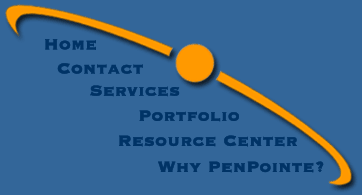

| PenPointe Tip Sheet |
Topic: Fish or Cut Bait: The Five Key Commitments of Web Sites By Sarah Hey It seems as if every business, every industry wants a web site these days. I should know, since I spend much of my time developing web sites and other interactive tools — and seemingly just as much time talking people out of creating web sites. Just how can a business owner, chief executive, or marketing director know that his or her company is ready to start down the path of creating a web site? And how can you save money and lost time by laying the groundwork early for your web site — before you call an interactive agency? You can start by measuring your own level of commitment, defined by the dictionary as “the state of being bound emotionally or intellectually to a course of action.” Read on to discover the first two of five key commitments necessary for web site development, as well as some ideas on how to prepare for your company's “grand entrance” on the World Wide Web. 1. Commit to a corporate visual identity. Does your company already have a “look” or “image”? If you've already spent money on your marketing materials, and established a visual style, your web site needs to match the overall visual identity of the rest of your marketing materials. It can use the same colors, the same logo, the same structure as your other company materials, but somehow the web site must be integrated within your total marketing look. The rule is, if people can recognize your company ads, brochures, letterhead, estimates, and invoices by their look without reading the content, then you have a distinctive visual identity that your web site needs to complement. As soon as customers and prospects see your home page, they should know it's your company, even without reading the content. And if you have not spent money developing your corporate identity — if, for instance, you have a bland logo or none at all — start that process first, before launching a web site. Web sites generally should complement a corporate visual identity that is already in place, not attempt to define it. 2. Commit to an overall marketing plan. As your corporate visual identity drives your web site's look and feel, your marketing plan will drive your web site strategically. Do you have a plan for reaching your customers and prospects through marketing tools? Do you have a budget? Do you have a message? Have you analyzed your ideal prospect and discovered where they are and what they read, view, and listen to? What are their favorite web sites? In our initial meetings with prospects, we often ask how they have reached customers in the past. Often, they've done nothing to reach customers, and want to start the process with a web site — and that's a mistake. Successful companies that use web sites as their primary marketing tool to reach customers and prospects also sink vast sums of money in driving people to their web site. Unless you have the budget of a Nike or JCrew, do not depend solely on a web site to increase sales and reach customers. On the other hand, a web site makes a great addition to an overall marketing plan, allows companies to offer better customer service, and reach new prospects. Think of a web site as just another communication tool in the toolbox for your company, or another spoke in the communication wheel. 3. Commit the money for a web site. Once you've established your visual identity and marketing plan, know that you will also need the money to both properly develop your web site — and to keep it running in the future. According to a BtoB Web Price Index, median web development costs for small web sites hover at $65,000. Larger web sites with more advanced features can run upwards of $250K. Of course, those fees are median prices, and you can find fine developers for smaller web sites for between $15K and $65K. But also know that once a web site is developed, it is, in one sense, like a hungry beast in a cave — it demands constant feeding of new content and other updates. You will need to invest in a corporate webmaster, either on-site or by contract, to add new content, visuals, and interactive tools. Fresh online tools encourage users to return to web sites, and that's exactly what you want your customers and prospects to do — see your company as a leading resource within your industry and the place to return to for more in-depth information. If you are not able to budget the money annually, as a part of your marketing plan, to constantly freshen and update your web site, then it's best to not start one. Save the initial development costs for other marketing efforts “off-line,” whether print, event or advertising-driven, rather than online efforts. 4. Commit to content. There is practically nothing more insulting to a customer or prospect who has made the effort to surf to your web site, then to learn nothing about your company, its products or services, your industry, tools and resources, and pricing. And that's just the beginning of content. You may want to gradually add interactive elements — “ask the experts” functions, online quoting and applying for services, chat abilities, email links to key people in your company, and more. Usually content falls into various categories: community-building, interactive elements, visuals (hopefully personal and customized, not stock), and corporate information. No reason, either, why your customer shouldn't be allowed to read current articles, white papers, and presentations from your employees. It's all about allowing your customers and prospects to see your company as a true resource with high-value expertise. You'll also need to invest in a writer who knows how to write for online audiences. Communicating online — in sentence structure, page length, tone and style, even through the use of keywords for search engine placement — is a whole new game, and entirely different from communicating in print or by radio or television. Your web site developer should be able to provide customized content for online media, and should use interviews with key corporate officers to develop that content. Information is one of the top reasons why people use online resources; if your web site is nothing more than a simple flyer, than it's probably best to not bother developing one. It can simply be a waste of money and time, as well as frustrating for those who are looking for deep content online. 5. Commit to marketing your web site. That's right. Your web site will need to be announced in the press, placed in search engines, and added in links in other online venues. You may want to choose to sponsor certain appropriate email newsletters to promote your site. And certainly you will want to announce your web site constantly through business cards, letterhead packages, and through direct mail and advertising by print, radio and television. A beautifully designed web site, packed full of informative content, fully integrated with your corporate visual identity and marketing plan, is utterly useless unless people know that it actually exists. If people don't know about its existence, your web site could be very much like a billboard on a highway down which no one drives. The billboard, like your web site, can sit alongside the empty blacktop, lonely, unread, expensive, and pointless. Your annual budget should include the money to promote your web site, both online and off-line. The process of planning and developing
a web site could take anywhere from six to 18 months, beginning with thorough
research into your online audiences and online competitors. And if
you can answer “yes” to all five of the key commitments, then you're probably
ready to begin that development planning. But as Peter Drucker says,
“Unless commitment is made, there are only promises and hopes, . . . but
no plans.” Sarah Hey is the Director of Marketing
Strategy for PenPointe, an Upstate company that specializes in developing
web sites, CD-ROMs, and other technology-enriched marketing tools for organizations. You
may contact her at sarah@PenPointe.com.
|
| PenPointe accuracy. PenPointe focus. PenPointe excellence. |
